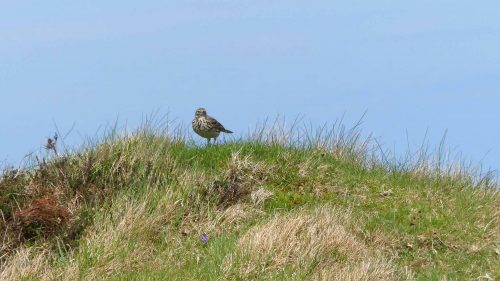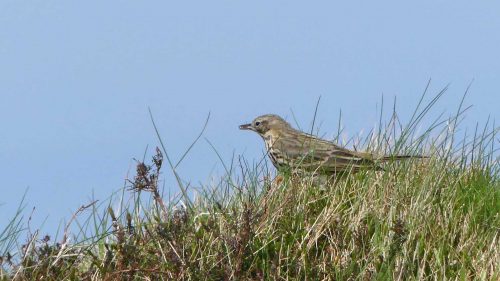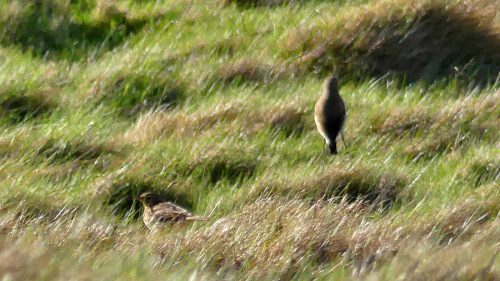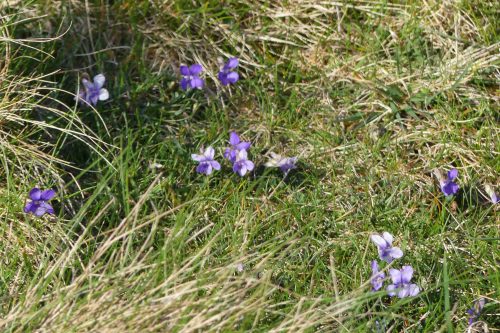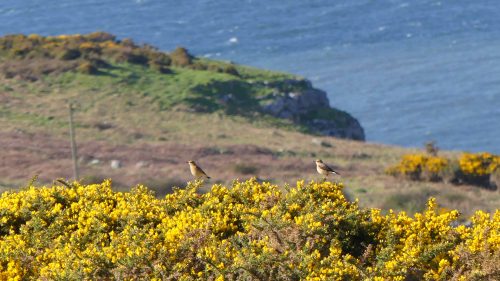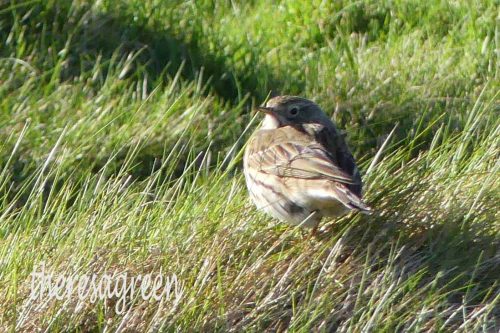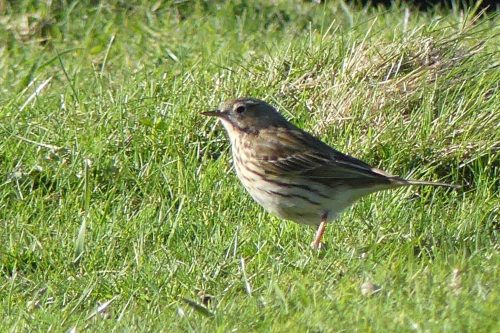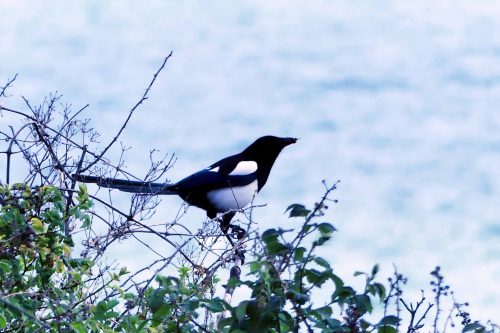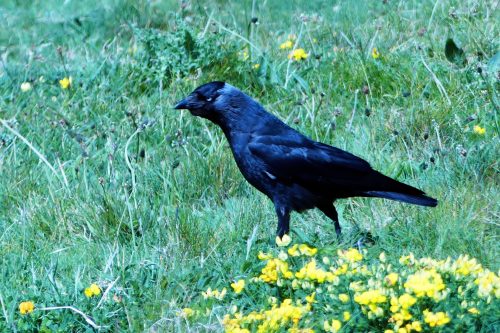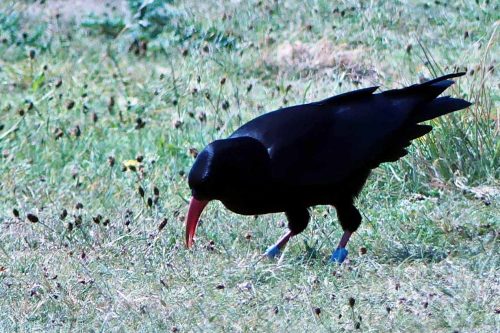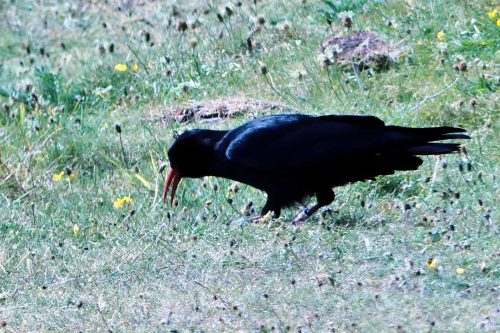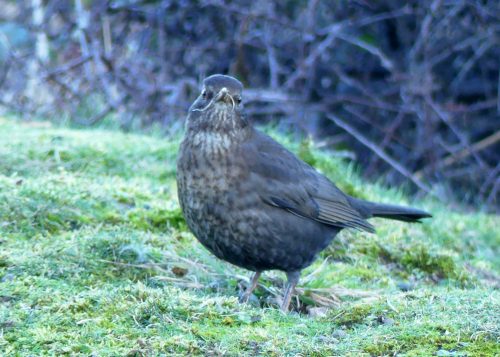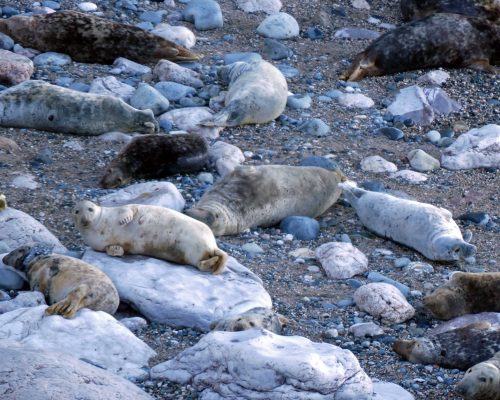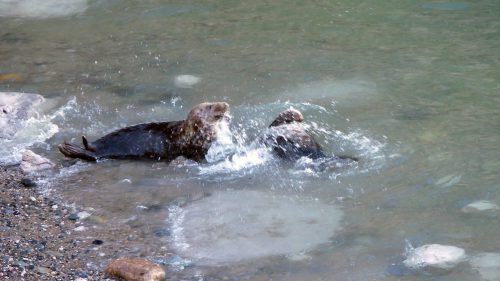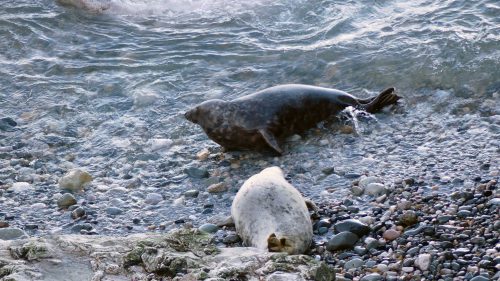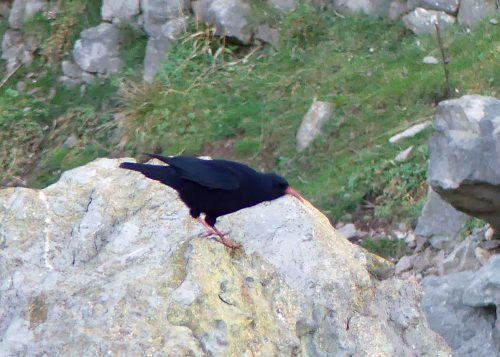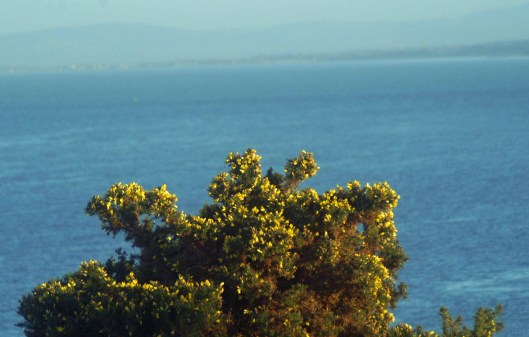Tags
birds on migration, chough, Greenland race of wheatear, meadow pipit, Northern Wheatear, Oryctolagus cuniculus, Pyrrhocorax, rabbit, Red-billed chough
April 25th – Great Orme
A bright sunny morning prompted me to leave early for the Great Orme today, giving myself time to walk at least part of the way up to the summit and arrive on time to do my shift in the Wildlife Trust shop. Bearing in mind that wherever I walked up from I would have to walk back down to later on, regardless of what the weather may be doing by then, I decided to park in the layby just beyond St. Tudno’s Church. It was much fresher up here, still sunny and clear but a strong breeze made it feel cool.
13:05 From here at the bottom of the steep slope, there are obvious short-cropped grass trails that lead off in various directions including up to the cable car station and the Summit Complex, where I was heading. Walking at a good speed it may take 10 minutes to get up to the top if you’re reasonably fit, or a bit longer if you stop to admire the views behind you or need to stop for breath on the steepest part nearer the top. Of course you all expect by now that I would take longer, as I would inevitably find things of interest that I would need to stop and photograph.
Either side of the tracks the hillside is lumpy and bumpy, with hillocks and hollows clothed with long tussocky grass and bushes of dwarf gorse; perfect terrain for the Meadow pipit that I was hoping to see. Birds foraging here are often well concealed, suddenly appearing and disappearing like this Magpie, one of a pair out hunting.
Sometimes they leave flying off until you’re almost on top of them, as this Jackdaw did.
Fond as I am of the Corvids, the unexpected sight of this elegant male Northern Wheatear was a lot more exciting.
and the excitement was doubled when a more softly plumaged female popped up onto the top of a hillock.
Absorbed with the female wheatear a distance away, a Meadow pipit popping up onto a hummock close by me took me by surprise, but a sighting at last and some photographs! It was hunting and I was pleased to get a pic of it with an insect in its beak.
Meadow pipits, in common with the majority of basically brown birds don’t get much of a write-up in the bird books. They’re mostly described as something like ” a small, brown, streaky bird, the most common songbird in upland areas, where it’s high piping call is a familiar sound’. Perhaps because of their lack of glamour we take them too much for granted, as according to the RSPB, ‘Meadow pipit numbers in the UK have been declining since the mid-1970s, resulting in this species being included on the amber list of conservation concern.’
It’s strange that we give such high praise to the similar-looking Skylark and the not-dissimilar Song Thrush and are so dismissive of the pipits. Is the bias based on the fact that the latter sing delightfully and pipits not so much? For sure our hills and uplands would be lonely without them, so perhaps we could appreciate them more and enjoy them at every opportunity.
There are little wildflower treats hidden down in the grass like this pretty violet.
13:25 As usual I’d been led astray by the birds and had to put a spurt on and get to the top in time to start my ‘shift’. As I said earlier it was breezy on this side of the Orme, but crossing the top and starting down the other side I was suddenly fighting to make progress against a continuous very strong head wind! Checking the wind gauge inside the visitor centre it indicated it was blowing in from a North-north westerly direction, so it felt cold too despite the sunshine. I anticipated selling more hats and gloves!
4:50 Finished for the day I retraced my steps along the trail back down towards where I left my car. On my own time now I was free to take my time and paused to admire the view over towards the Little Orme and beyond. The post tells you that this is the way to The Town (Llandudno).
A closer view of the Little Orme shows its intact, non-quarried side which was deliberately preserved to present a much prettier view to visitors and residents of Llandudno.
A little further on there is an interpretation panel that reminds you that this is the ‘Historic Trail’ and informs that 800 years ago you would have been looking down onto one of perhaps three villages established on the Orme, whose inhabitants would have grown crops and raised animals to eat or trade.  I was hoping the wheatears may still be around and I was in luck – I soon spotted a female.
I was hoping the wheatears may still be around and I was in luck – I soon spotted a female.
 The sun was lower now, creating shadows and highlights and the wind, stronger now, rippled across the long silvered grass, creating a magical almost alien landscape. In amongst it I realised there were more Wheatears, another three birds.
The sun was lower now, creating shadows and highlights and the wind, stronger now, rippled across the long silvered grass, creating a magical almost alien landscape. In amongst it I realised there were more Wheatears, another three birds.
All Wheatears spend winter in tropical Africa, heading northwards via Spain in the spring. Those that breed in the British Isles sometimes arrive on our coast as early as late February, but mainly during March, with males arriving ahead of females. They move inland to breed.
GREENLAND WHEATEAR
It is possible that the birds I saw here today belong to another race, known as the Greenland wheatear, which arrives a little later in April. Many wheatears make a refuelling stopover in North Africa, but as the Greenland wheatears fly furthest, they need to put on more fat before leaving and spend longer at stopovers. They have a long journey ahead to their breeding sites on the other side of the Atlantic. From Britain they fly northwest across the sea, via Iceland, until they reach the Arctic tundra of Greenland and northern Canada. By June they will have started to breed there.
Whichever they were I was appreciating some lovely views of the two males and two females foraging together in the long grass, using the little hillocks as look-out platforms to survey the ground around them for likely prey.
Then a distraction; a black bird flew in that I may have dismissed as a Jackdaw had it not called out. This was a Chough. It had landed somewhere behind a particularly hillocky part of the hillside, which is also pitted with well-disguised sunken craters. You have to watch your footing if you risk going off the proper trails.
I walked carefully until I spotted the bird, almost up to its beak in the long grass.
It had its back to me, eventually turning enough to show its diagnostic curved bill and legs, these are bright red in an adult bird, but this was a juvenile so it hasn’t quite got that far yet and its are more of a dull orange colour.
It didn’t stay for long before taking off, but it’s always a treat to see them at all, especially this closely.
Making my way back to the main track I noticed this rock, a little island rising out of a sea of grass and heather, it was almost totally encrusted with white lichen and embellished with mosses.
There was a lovely patch of violets growing in a grass-lined crater too.
I spotted two Wheatears perched on the top of a gorse bush; a male and a female. The birds spend most of their time on the ground, travelling in hops or runs on the ground, so it’s quite unusual to see them perched up higher.
I couldn’t have asked for a prettier picture than a handsome male Wheatear perched amongst golden-flowered gorse. 
I liked the two images below too; perfect records of the birds’ exact location!
Two males together on the short turf of the trail
And one last image of a nicely posed one on his own.
17:16 Walking on down I spotted three bunnies on high alert, in poses that could have come straight out of Watership Down.
But then I saw the new Peter Rabbit film during the Easter holiday too and thought this one, which I think may be the ‘big bunny’ of a previous post, may have seen it too – he’s got Peter’s pose to a ‘T’.
And wouldn’t you know? After all my efforts to find a Meadow pipit, there was one posing on a rock almost in front of my parked car!
It flew down to the ground and looked back over its shoulder at me as if to say
“what kept you? I’ve been here for hours waiting for you!”
It allowed me a couple of photographs, then took off, leaving a lone Jackdaw to patrol the layby edge for his supper.
On the way down I had to stop just past the church as these little Goldfinches fluttered down onto the bare ground of a bank where they must have spotted food potential.
The views were stunning as always; good today as the mountains were more clearly visible than usual and the clouds above added to their drama.
17:45 The view of the Conwy Estuary was stunning too, the sun was hitting the castle perfectly so it stood out from the trees, you can clearly see the road bridge that takes you across the river to the town and there were boats on the water….. the perfect scene for a painting.
The view of the sea meeting West Shore wasn’t bad either.







